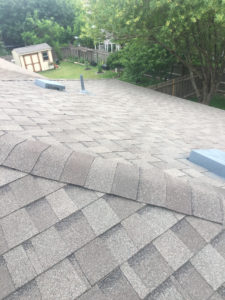 In Austin and Central Texas, May and June are typically the wettest months, averaging more than four inches of rain each. After the relatively low amounts of precipitation received throughout the winter, spring rains have a way of bringing to light any problems that your roof may have. Typically, the problems began months earlier, but they were either ignored or not obvious enough to reveal themselves. Whether you own a commercial roofing or residential roofing building, here are some signs of an issue with your roof that frequently manifest in the spring.
In Austin and Central Texas, May and June are typically the wettest months, averaging more than four inches of rain each. After the relatively low amounts of precipitation received throughout the winter, spring rains have a way of bringing to light any problems that your roof may have. Typically, the problems began months earlier, but they were either ignored or not obvious enough to reveal themselves. Whether you own a commercial roofing or residential roofing building, here are some signs of an issue with your roof that frequently manifest in the spring.
What Are Some Common Springtime Roofing Problems?
Although all of the following problems could appear in any season, the issues discussed below are the ones that are more likely to go undiscovered until spring arrives.
• A roof leak is by far the most obvious sign of a problem. Sometimes, a minor leak will not reach the interior of the building until there is a significant amount of rain that falls in a relatively short time. In many cases, the breach has existed for several months, and during that time, the water has been traveling horizontally under the roof covering or the leak has been small enough that the water has not penetrated through the attic insulation. Check for water stains on interior ceilings, damp or mildewed attic insulation, damaged paint on interior walls and damp spots in the attic.
• Gutters can become clogged with leaves, pine needles and twigs. When it rains, the water cannot reach the downspouts, so it will overflow and run down the exterior walls or back up beneath the roof covering. Overflowing gutters can damage your siding, your foundation and your landscaping. New gutter installation and cleaning is important — clean your gutters at least twice each year to ensure that runoff will flow freely and safely away. Look for and repair gutters that are loose, sagging or cracked.
• If you hear or see animal activity on your roof, you may have a problem. Squirrels, birds and other small animals will build nests in unused chimneys and damaged soffit, behind rotted fascia boards, in damaged siding and behind flashings that are loose or broken. Some animals will even move into your attic to nest over the winter, and they may be reluctant to relocate once warm weather arrives — especially if they still have babies in the nest.
• Older chimneys should be inspected to ensure that they will not allow water to penetrate. Missing, cracked or damaged chimney caps can allow water to leak down the sides of the chimney. Bricks and mortar should be checked and repaired as needed to prevent additional damage to the chimney as well as to prevent potential leaks.
• If you have black streaks on your roofing shingles, you probably have algae growing on your roof. These marks can be extremely unattractive, but they do not do much damage to your shingles. Shingles containing copper granules are now available that prevent the growth of algae, and there are copper strips that your roofer can install to prevent algae from returning.
A professional roof inspection by Alpha Roofing can help you discover issues with your roof so that the situation can be remedied before serious damage is done. We are an award-winning roofing company offering a wide range of services, including roof, chimney and flashing repairs. We also install wood siding, asphalt shingles, flashing, skylights, metal roofing systems and flat roofs. In addition, we remove debris and moss, offer metal fabrication services, and offer preventive maintenance plans. We have earned an exemplary reputation for our integrity, workmanship, professionalism and customer service. For a free estimate, submit the quote request form online or call 512-777-1086.
